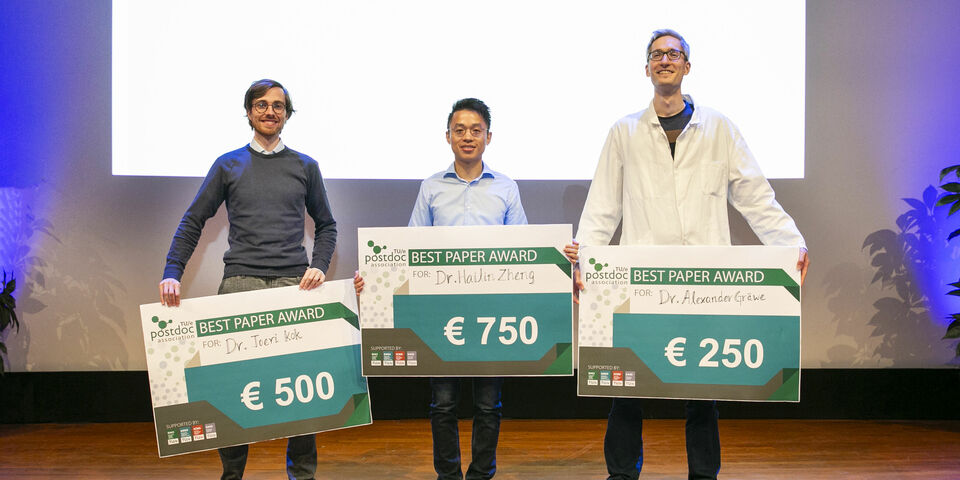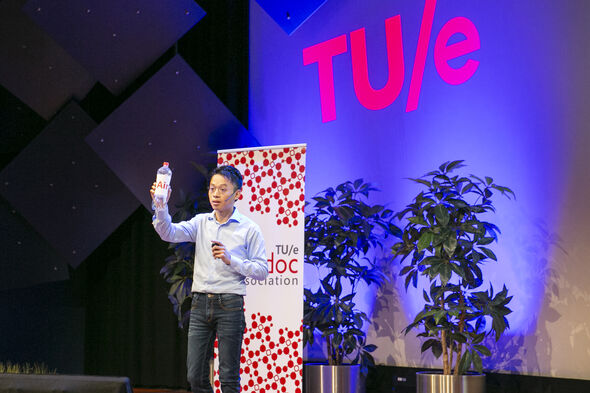Research air quality at child daycare centers wins Best Paper Award
Seven nominated TU/e postdocs gave a short pitch about their research on Monday afternoon, on the occasion of the annual Best Paper Award ceremony organized by the TU/e Postdoc Association (PDA). Hailin Zheng won an amount of 750 euros for his research into improving air quality at child daycare centers.
For a brief moment, the transparent test tube that postdoc Alexander Grwe is holding turns fluorescent blue. Dressed in a slightly creased white lab cat, he has taken to the stage of the Blauwe Zaal in the Auditorium. Gräwe is one of seven postdocs competing for the postdoc Best Paper Award this year. This is the fourth time in its existence that the Postdoc Association is giving out this award, which is a collaborative initiative with the four TU/e research institutes – ICMS, EAISI, EIRES, and EHCI. Its sponsoring rotates between the different institutes; this edition is organized by the Eindhoven Hendrik Casimir Institute.
Pitches
The postdocs have three minutes to pitch their research papers to the jury, which is chaired by EHCI Managing Director Wieteke de Boer, and the other people present. The turnout could have been better, with the majority of seats in the Blauwe Zaal having remained empty. This doesn’t say anything about the topics that are featured, however, as all of them are appealing and very diverse. They include city designs that encourage people to exercise, using iron powder to make hydrogen storage more efficient, and a calculation model to distribute the costs of CO2 transport. In the short amount of time they have to convince the audience and the jury, it’s crucial to get down to the core of the research right away, as well as stress its societal relevance. This is very important, confirms Barry Fitzgerald, host on behalf of the Communication Expertise Center. “As a researcher you must of course be innovative, but also aware of how your research can contribute to society.”
Finding a viruse with light
This year sees the introduction of the audience award. After the pitch, those present can use an interactive tool on their cell phones to rate the postdoc’s effort for such things as clarity, communication style, and the use of ‘visuals and props’. The audience elects Alexander Gräwe (Biomedical Engineering) – the guy with the blue light – as its favorite, which means he’s presented with a check for 250 euros. His research, entitled Light catches virus in the act, demonstrates a new way of quickly and accurately diagnosing infectious diseases using bioluminescence.
Visualizing the spine
According to Wieteke de Boer, the jury had a very hard time picking a winner, and she praises the clear presentations by them and by the runner-up. The latter, taking home an amount of 500 euros, turns out to be Joeri Kok (Biomedical Engineering), for his paper Spine mechanics for everybody. Using MRI images, he can create a model that provides an insight into the individual spinal column and offer support to medical specialists.
Poor air quality in daycare
The winner of the PDA Best Paper Award is Hailin Zheng (Built Environment). He uses an empty soda bottle to demonstrate how much air toddlers breathe in every day, but what’s most shocking of all is his researchInvisible threats inside babybeds, which shows that a considerable portion of that air in child daycare centers is of bad quality. Arts and crafts activities, such as painting and gluing, as well as cleaning agents can increase the amount of volatile organic substances to dangerous levels. However, in his measurements Zheng has found the most ‘polluted’ air in semi-enclosed duo beds, in which the youngest children in particular tend to spend a lot of time. He hopes that his research will raise awareness of air quality in the daycare center sector and also suggests ways of improving it. These include more and personal ventilation, “to help kids breathe cleaner air.”
Making connections
At the end of the ceremony, host Barry Fitzgerald points out to the postdocs present that while publishing is certainly important, the same goes for making connections: to society, to young people in schools, and to each other. And that’s exactly what PDA chair Dimitra Dritsa tries to do. “We want to bring postdocs at TU/e together and provide different kinds of support to these young researchers. By teaching grant application and stress management workshops, for example, but also by giving them the opportunity to present their research to a broad audience in a low-threshold setting, like today.” Although Dritsa indicates she thinks “the event was successful and featured a lot of exciting research”, she also mentions the somewhat disappointing turnout of both participants and spectators. “There are so many postdocs at TU/e, all of them working on interesting and challenging projects. So our task is to find a way to showcase all of that research in future editions of this event.”
Postdoc in the Picture: Hailin Zheng
You’re at a birthday party. How do you explain your research in one sentence?
“I’m working to help kids breathe cleaner air.”
How is your research relevant to society?
“Clean air is important for everyone, but also – and especially – for young children. Their lungs and other organs are still very much developing, which makes them extra sensitive to air pollution. The short-term and long-term pollution exposures in infancy and early life cause lasting damage to cells and tissues, and increase the subsequent risk for all kind of diseases, including respiratory and neurodevelopmental disorders, and pediatric cancers. Even at low exposures. We are trying to raise awareness of the importance of healthy indoor air in child daycare centers, the place where children spend a large part of their day. Opting for another glue or paint and a more deliberate ventilation policy can already make a huge difference.”
What kind of object do you use to make your research more relatable?
“Air quality is fairly abstract and invisible, but people generally have an easier time relating to the quality of water (especially drinking water). That’s where the soda bottle comes in, which also makes for a practical way of showing how much air you breathe in every day. For young children, this can be up to 7,000 liters.”
What will your next paper be about?
“I completed my PhD very recently and just started a postdoc where we zoom in on the indoors environment at work, at school and at home. The new research is not only about air quality, but also, the effect of light, noise, and temperature on occupants indoors. Notably, I focus on the latest building technology solutions to improve the indoor environmental quality, under the context of Healthy Building movement”
What are you going to do with the money you won?
“First, of course, I'll celebrate with my family, friends, and colleagues who supported me at the event. Then, I plan to buy advanced air quality sensors. I’m passionate about developing sensing technologies to monitor air quality, especially for personal exposure levels.”



Discussion